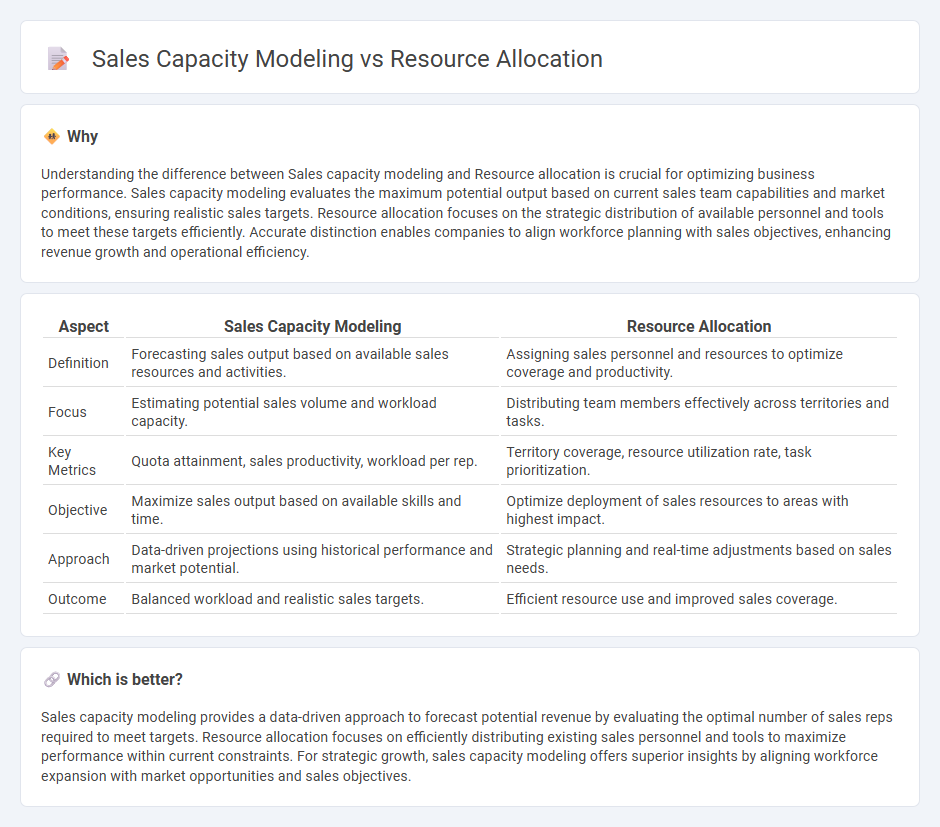
Sales capacity modeling predicts the maximum sales volume a team can achieve based on factors like workforce size, skill levels, and sales cycle length. Resource allocation focuses on distributing available sales personnel and tools efficiently to meet sales targets and optimize performance. Explore deeper insights into balancing these strategies for superior sales results.
Why it is important
Understanding the difference between Sales capacity modeling and Resource allocation is crucial for optimizing business performance. Sales capacity modeling evaluates the maximum potential output based on current sales team capabilities and market conditions, ensuring realistic sales targets. Resource allocation focuses on the strategic distribution of available personnel and tools to meet these targets efficiently. Accurate distinction enables companies to align workforce planning with sales objectives, enhancing revenue growth and operational efficiency.
Comparison Table
| Aspect | Sales Capacity Modeling | Resource Allocation |
|---|---|---|
| Definition | Forecasting sales output based on available sales resources and activities. | Assigning sales personnel and resources to optimize coverage and productivity. |
| Focus | Estimating potential sales volume and workload capacity. | Distributing team members effectively across territories and tasks. |
| Key Metrics | Quota attainment, sales productivity, workload per rep. | Territory coverage, resource utilization rate, task prioritization. |
| Objective | Maximize sales output based on available skills and time. | Optimize deployment of sales resources to areas with highest impact. |
| Approach | Data-driven projections using historical performance and market potential. | Strategic planning and real-time adjustments based on sales needs. |
| Outcome | Balanced workload and realistic sales targets. | Efficient resource use and improved sales coverage. |
Which is better?
Sales capacity modeling provides a data-driven approach to forecast potential revenue by evaluating the optimal number of sales reps required to meet targets. Resource allocation focuses on efficiently distributing existing sales personnel and tools to maximize performance within current constraints. For strategic growth, sales capacity modeling offers superior insights by aligning workforce expansion with market opportunities and sales objectives.
Connection
Sales capacity modeling provides data-driven insights into the potential output of a sales team based on factors such as personnel skills, market demand, and territory coverage. Resource allocation uses these insights to strategically assign sales representatives, budgets, and tools to maximize efficiency and revenue generation. Accurate sales capacity models enable optimized resource allocation, ensuring balanced workloads and achievement of sales targets.
Key Terms
Quota Assignment
Effective quota assignment hinges on the strategic interplay between resource allocation and sales capacity modeling, optimizing team performance and revenue targets. Sales capacity modeling projects available sales hours and skills, ensuring quotas reflect realistic workload distributions, while resource allocation aligns personnel and budgets to meet these targets efficiently. Explore how integrating these approaches enhances quota precision and drives sustainable sales growth.
Territory Planning
Resource allocation in territory planning optimizes workforce deployment by analyzing market potential, sales targets, and existing customer data to maximize coverage and revenue. Sales capacity modeling quantifies the sales team's ability to meet goals based on skills, cycle times, and workload balancing across territories. Explore advanced strategies to enhance your territory planning and achieve superior sales performance.
Headcount Forecasting
Resource allocation optimizes the distribution of existing personnel and budgets across projects to maximize efficiency, while sales capacity modeling projects future revenue potential based on available headcount and skill set. Headcount forecasting specifically evaluates workforce needs by analyzing historical sales data, quota attainment, and turnover rates to ensure the right talent mix supports growth objectives. Explore how integrating these approaches enhances strategic workforce planning and drives sales performance.
Source and External Links
What Is Resource Allocation? - IBM - Resource allocation involves strategically distributing and managing resources like human, physical, and financial assets to meet project objectives.
What is Resource Allocation? A Guide to Project Success - This guide provides insights into the importance of resource allocation and offers best practices for improving the allocation process.
What Is Resource Allocation? An Expert Guide - NetSuite - Resource allocation is a multistep process involving understanding project scope, determining necessary resources, and creating a plan for optimal resource utilization.
 dowidth.com
dowidth.com